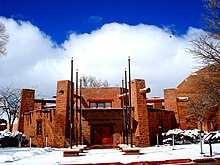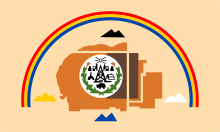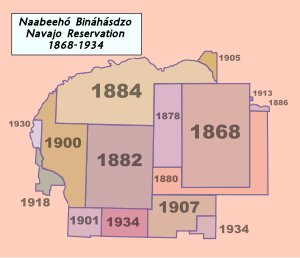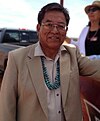Navajo Nation Reservation

The Navajo Nation Reservation ( Navajo : Diné Bikéyah / Naabeehó Bikéyah ) is the largest Indian reservation in the United States with 67,339 km² and is the size of the state of Bavaria . It was contractually guaranteed to the Diné Indians in 1868 by General William T. Sherman . The capital is Window Rock , Arizona .
location
The Navajo Nation Reservation is located in the sandstone desert on the border between the states of Utah , Arizona and New Mexico south and west of the Four Corners point . It is part of the Colorado Plateau at an altitude of 1500 to 2000 m above sea level. d. Sea level . In addition to various canyons and large river systems, the country is known for its table mountains (Spanish: Mesa ) and other attractions such as Monument Valley , Canyon de Chelly and Antelope Canyon .
The Hopi Reservation is an enclave within the Navajo Nation Reservation .
Territorial development
In the middle of the 19th century, there were three ways for Indians to acquire land. The ability to achieve this through a treaty with the United States government - as in the treaty of June 1, 1868 - was abolished by Congress by law of March 3, 1871, as there was no longer any Native American tribe within United States territory should be recognized as an independent (and thus contractually capable) nation. The Navajo Reservation is the only reservation in Arizona that was originally contractually established, and is also older than the state of Arizona itself, which was only incorporated as the 48th state in 1912. The other possibilities were the assignment of ownership by ordinance of the federal government or by a federal law .
The reserve assigned in the contract of June 1, 1868 covered an area of 3,500,000 acres (approx. 14,164 km²). As a result, the area was expanded several times to almost five times the area by:
- Ordinance of the Federal Government of October 29, 1878
- Ordinance of the Federal Government of January 6, 1880
- Ordinance of the Federal Government of December 16, 1882 (approx. 2.5 million acres for the Hopi and other Indians)
- Ordinance of the Federal Government of May 17, 1884
- Ordinance of the Federal Government of April 24, 1886
- Ordinance of the Federal Government of January 8, 1900
- Ordinance of the Federal Government of November 14, 1901
- Ordinance of the Federal Government of May 15, 1905 / Federal Act of March 1, 1933
- Ordinance of the Federal Government of November 9, 1907/28. January 1908
- Ordinance of the Federal Government of December 1, 1913
- Ordinance of the Federal Government of January 19, 1918/23. May 1930 / Federal Law of June 14, 1934
- Federal law of May 23, 1930
- Federal law of June 14, 1934
population
The figures below are based on the official publications of the 2010 US Census and the fact sheet published by the Navajo Nation government .
With the data on the Navajo population a distinction must be made between
- the number of residents in the Navajo Nation Reservation
- the number of people who declared themselves (regardless of their place of residence) as belonging to the Navajos Tribal Group in the census
- the number of those who have declared themselves to be part of the Navajo Tribal Group and live in the Navajo Nation Reservation.
- Residents in the Navajo Nation Reservation
In 2010, a total of 173 667 residents were recorded on the territory of the Navajo Nation (including the off-reservation trust land ). The area of the Navajo Nation Reservation spans three states. The following shows the population figures according to this breakdown.
| area | Residents |
| in the state of Arizona | 101 816 |
| in the state of New Mexico | 42 127 |
| in the state of Utah | 6 068 |
| * Navajo Nation Reservation | 150 011 |
| in the state of Arizona | 19th |
| in the state of New Mexico | 23 637 |
| * Off-Reservation Trust-Land | 23 656 |
| ** Reservation + Off-Reservation Trust-Land | 173 667 |
The following shows the population by ethnic composition, using largely the terms of American statistics. Since people could ascribe themselves to more than one ethnic group, the total number of inhabitants cannot be divided among the ethnic groups - instead, the proportion of the total number of responses (including multiple responses) is shown. The proportion of the other Indian groups was calculated.
| Population group | Percentage ownership % |
| Navajo | 88.9 |
| other Indian groups | 7.1 |
| * American Indian | 96.0 |
| White | 2.8 |
| African American | 0.4 |
| Asian | 0.3 |
| Others | 0.5 |
| ** Total | 100.0 |
- Belongs to the Navajo Tribal Group
The number of people who declared themselves (regardless of place of residence) in the 2010 census as belonging to the Navajos Tribal Group alone amounts to 286,731; those who have declared themselves to belong to the Navajos alone or to other tribes or races 332 129. People could declare themselves to belong to several ethnic groups. This was the case with the Cherokee to a particularly large extent, which is why this tribal group is numerically the largest with 819,715 people. If the focus is only on those people who only consider themselves to belong to one group, then the Navajo with 286 731 are slightly stronger than the Cherokee with 284 247.
- Belongs to the Navajo Tribal Group and lives on the Navajo Nation Reservation
This number can not be found in the cited publications of the US Census Bureau . According to the Navajo Tourism Department's fact sheet , it amounts to 156,823. This number is given in connection with the total number of people declaring themselves as Navajo of 332,129, which also includes people with multiple declarations. According to the Census, the American Indian living on the territory of the Navajo Nation was 169,321 (also including multiple mentions). From this it follows that in addition to the Navajos there were also 12,498 people who were known to other tribal groups.
On June 1, 1868, two federal government commissioners and a group of Navajo leaders and former war chiefs signed a treaty at Fort Sumner , where around 8500 members of the Diné people (Navajo) were interned at the time. 18 Diné representatives signed the contract with their "X". Barboncito was the main speaker during the negotiations and was viewed by government officials as the most important chief. The contract secures the Navajo Reservation in northwestern New Mexico Territory and northeastern Arizona Territory to
The old men as mediators between the tribe and the Indian agent
In order to be able to better control the reservation, the Bureau of Indian Affairs (BIA) used a puppet self-administration . In this Barboncito as paramount chief and Ganado Mucho (for the West) and Manuelito used (for the East) as sub-chiefs.
In the years that followed, the Bureau of Indian Affairs appointed chiefs who, on the one hand, had at least a certain degree of acceptance in the tribe and, on the other hand, were willing to work with the Indian agents. Although there was no self-government, no elected representatives and no governmental power, the multiple expansion of the reservation and the sharp increase in population and livestock shows that the chiefs were not unsuccessful in representing the interests of their people.
The 1923 Tribal Council - an economic necessity
Mineral resources were found in the area of the reservation (oil, gas, coal, minerals) which the Bureau of Indian Affairs (BIA) believes should be exploited, and the use of forests and water also required regulation. Until 1923, all natural resources were considered the property of the local community of Indians living at the sites. The BIA organized full assemblies of these residents, since, according to Article X of the contract of June 1, 1868, the consent of at least 75% of the adults had to be given in the event of a land transfer or the award of concessions .
Since a delimitation of the local communities of the 75, as well as the finding -% - quorum were difficult and controversial, there have been disputes with the result that the Ministry of the Interior ( Department of the Interior ) did not recognize the concessions - the economic situation demanded Legal certainty . The Ministry of the Interior now pursued a new legal concept that the natural resources in the area of the reservation were no longer owned by the local communities but by the Navajo tribe as a whole. A body with legal capacity had to be created for this owner .
As early as 1922, a business council with dubious legitimacy for the Navajo tribe acted as a negotiating partner for interested companies. In January 1923, the head of the Bureau of Indian Affairs (BIA) announced Regulations Relating to the Navajo Tribe of Indians , which established a Tribal Council . In addition to a chairman and his deputy, a delegate and a deputy should be elected in each of the six Navajo Agencies of the BIA. As early as April 1923, the allocation of seats to the BIA districts was revised so that one delegate represented an approximately equal number of tribesmen. The council thus received 12 members and a chairman. The first meeting of the council took place on July 7, 1923.
At the same time, the BIA reorganized its administration for the reservation and appointed a senior official (commissioner) , who now supervised all six BIA districts of the reservation. At its first meeting, the tribal council authorized the senior official of the BIA to sign concession agreements on behalf of the tribe. In 1927 and 1928 minor modifications were made to the rules for the tribal council - it was not until 1936 that they were reorganized.
In 1927 the head of one of the six Navajo Agencies (administrative districts) of the BIA introduced local organizations known as Chapters and entrusted with self-governing tasks. The system was transferred to the other BIA districts, but failed in the disputes about regulations to avoid overgrazing and the associated reduction in livestock (around 1932).
Consistent separation of powers in 1989
After the previous system under the long-standing chairman (Chairman) had a dominance of the Chairman as head of the executive and legislative Peter MacDonald (1970-1989), took place after MacDonalds deposing a reorganization. The function of the President (President) , next to the chairman of the council, a Chief Executive was institutionalized.
The constitutional conflict 2010
The self-government of the Navajo Nation follows the principle of the separation of powers. The executive was led by Joe Shirley Jr. (President 2003-2011) and Ben Shelley (Vice President). In 2010 she found herself in a serious conflict with the legislature , the Navajo Nation Council and its President (Speaker) , Lawrence T. Morgan. The judiciary is represented by the Chief Justice , Herb Yazzie. At the end of October 2009, Shirley was given leave of absence by the Navajo Nation Council. On December 14, a subordinate district court had prohibited the execution of the council's decision by way of an injunction. The council accused the executive of irregularities in the conclusion of contracts with private companies. The Supreme Court ruled on May 28 that the Council's decision to grant Shirley's leave of absence was invalid. An investigation has been opened against Shirley and six members of his administration. The appointed special investigator extended his investigations to include the allocation of funds by the members of the council and brought charges against 77 of the 88 MPs for theft and fraud. On July 30, 2010, the Supreme Court ruled that under current law, Shirley would not be allowed to run for a third term immediately, while he could run again in subsequent elections.
From the 2010 elections, Shirley's previous deputy, Ben Shelley, emerged as the winner.
Elections 2014/2015
The Primary Elections took place on August 26, 2014, with Joe Shirley ahead with just over 21% and Chris Dechene with 19%. Russell Begaye came third with 14.4%. The deadline for the runoff between the two leading applicants in the area code was set for November 4th.
With reference to the requirements set out in the electoral code, Dechene's qualifications were questioned as he was not fluent in the Navajo language. The competent court decided that the third-placed, Russell Begaye, would go into the runoff election instead. The legal disputes led to the election being postponed.
In the April 4, 2015 election, Begaye received 25,745 and Shirley 15,439 votes. On April 21, 2015, at the request of the supporters of Shirley, a manual recount of the votes took place in 10 voting districts (chapter), which did not lead to any relevant change in the result (25 902 to 15 245). He took office on May 12, 2015.
Compensation for mismanagement
In 2006 the Navajo Nation sued the US federal government for $ 900 million in damages. Federal authorities have made management mistakes in the fiduciary management of Navajo Nation assets. From 1946 to 2012, income from the issuing of licenses for the use of raw materials should not have been invested sensibly. The damage including interest and costs should be compensated by the federal government.
In May 2014, the Obama administration sought a settlement with the Navajos and offered them US $ 554 million in compensation. On May 30, 2014, the Navajo Council - the Parliament of the Navajo Nation - approved the settlement by 13 votes to 3. The agreement was ceremonially signed on September 26, 2014 in Window Rock.
Of around 100 lawsuits from various Indian nations, around 80 have now been settled through settlements, whereby the settlement with the Navajos is by far the most expensive for the US government.
COVID-19 pandemic
The Navajo Reservation has a higher rate of COVID-19 infection than anywhere else in the United States . A disproportionately large number of people there suffer from diabetes, obesity or high blood pressure and thus belong to the risk group. In many places in the settlements it is not possible to keep your distance; many have no running water.
Arizona's Governor Doug Ducey did not impose mask requirements , though streams of visitors came to Arizona. The rate of new infections tripled within two weeks ; Arizona (along with Texas and Florida) became a new corona hotspot.
President Jonathan Nez, in office since 2019, is the 9th President of the Navajo Nation:
All previous presidents belonged to the Democratic Party .
life situation
The Navajo have their own government, which is freely elected, and their own police force . The traditional form of living are hogans , a round building made of wood and stones, some of which are built into the earth and are scattered across the country. The poverty in the reservation is similar to that in a third world country . More than half of the approximately 269,000 inhabitants ( Census 2000) live below the poverty line. The average annual income is just under $ 11,885 per capita, around a third of that of the rest of the United States. The unemployment rate is around 40 percent.
By the uranium mining tremendous health burdens created since the 1940s to society. In addition to the mining workers, cattle, drinking water and building materials were also contaminated, resulting in numerous deaths, cancer cases and deformities. No-go areas still exist today . Compensation was only awarded to the miners in 1990.
Many Diné breed sheep, cattle or horses. Other earning opportunities exist only in the manufacture and sale of handicrafts, blankets, silver and turquoise jewelry, in tourism and in mining. Young people with good school leaving qualifications leave the reservation to study and are valued as experts, particularly in construction, both in the US and abroad. They then support their often very large families in the reserve.
In March 2010, the US government allocated $ 32 million to make broadband Internet connections available on the reservation, thereby creating new job opportunities. Since 2013, the Navajo Nation administration has maintained a data center that offers professional hosting and other Internet services to companies in the region .
The reserve has also been affected by the COVID-19 pandemic since March 2020 . As of May 10, 2020, there were around 3,000 confirmed infections and around 100 deaths.
See also
Web links
|
Further content in the sister projects of Wikipedia:
|
||
|
|
Commons | - multimedia content |
|
|
Wiktionary | - Dictionary entries |
|
|
Wikivoyage | - Travel Guide |
- Official website of the Navajo Nation (Diné )
- Navajo Nation community profile on The Native Peoples Technical Assistance Office (NPTAO) homepage of the University of Arizona ; accessed on May 11, 2020
- Navajo Tourism Department homepage , accessed May 13, 2020
- Navajo Times website (English)
- The newspaper Kayenta Today website (English)
- Text of the contract dated June 1, 1868
- David Eugene Wilkins: The Navajo political experience in Google Book Search
- List of Navajo Nation leaders (English)
- Ed Becenti: Navajo culture and corruption culture . In: Navajo Times of December 12, 2013 (English)
- Marilyn Berlin Snell: Navajo Monster Slayers: a tribe struggles to fight corruption . In: High Country News of 22 July 2011, accessed on April 18, 2014 (English)
literature
- Robert W. Young: A Political History of the Navajo Tribe. Tsaile 1978 (English)
- Ruth Underhill: The Navajos. University of Oklahoma Press, Norman, OK 1956 (English)
- Clyde Kluckhohn, Dorothea Leighton: The Navaho. Harvard University Press, Cambridge, MA 1974 (English)
- Jack Breed: Better Days for the Navajos. In: National Geographic Magazine, 12/1958, pp. 809-847.
- Robert W. Young: The Origin and Development of Navajo Tribal Government. In: Navajo Yearbook. Report No. viii, Window Rock, AZ 1961.
Individual evidence
- ^ According to Testimony of the Navajo Nation
- ^ Bernard L. Fontana: Historical Foundations. In: Thomas Weaver (Ed.): Indians of Arizona. Tucson, AZ 1974.
- ↑ s. Breed, p. 814.
- ↑ s. Underhill p. 149; a map with the extensions is also shown there
- ↑ see Jerry Kammer: The second long walk: the Navajo-Hopi land dispute , Albuquerque 1987, p. 27 in the Internet Archive ; this regulation is the starting point for the later land dispute between the Hopi and the Navajo.
- ↑ Tina Norris, Paula L. Vines, and Elizabeth M. Hoeffel: The American Indian and Alaska Native Population: 2010 , January 2012, Report Number C2010BR-10; Table 7. American Indian and Alaska Native Population by Selected Tribal Groupings: 2010 ; Summary Population and Housing Characteristics: 2010 2012, Report Number CPH-1, US Census Bureau, Table 40. Land Area and Population Density : 2010 — Con. and Table 33. Age and Sex for the American Indian and Alaska Native Population (One Race): 2010-Con. and Table 35. Population for Selected Categories of Race for American Indian and Alaska Native Areas: 2010 — Con.
- ↑ Fact Sheet. Population / Demographics: on the Navajo Tourism Department homepage ; accessed on May 11, 2020
- ^ Lieutenant General WT Sherman and SF Tappan; s. contract
- ↑ see Diné
- ^ S. Underhill, p. 142; s. Young, p. 35.
- ^ The federal territory of New Mexico was divided into the territories of New Mexico and Arizona in 1863; Both states did not become states until 1912.
- ^ S. Underhill, pp. 160/161.
- ↑ In 1921, oil was found in the area of the original reservation, s. Young 1961, p. 374.
- ↑ For the text of the regulations, see Young 1961, p. 393 ff.
- ↑ For the detailed regulations see Young, 1961, p. 395.
- ^ S. Young, 1961.
- ↑ See information on the official homepage of the Navajo Nation.
- ↑ S. Homepage of the Chief Justice and the pamphlets of the parties available there.
- ↑ Navajo Nation Supreme Court: Court decision of May 28, 2010 (English)
- ↑ Felicia Fonseca: Navajo leaders turn to prayer amid investigation Deseret News October 29, 2010 (English)
- ↑ Navajo Nation Supreme Court: Judgment of July 30, 2010 (English)
- ↑ See official election results
- ↑ for further information on the 2010 election see also the special article in the English language Wikipedia Navajo Nation presidential election, 2010
- ^ Results on the Navajo Election Administration homepage
- ^ Election results on the Navajo Election Administration homepage ; navajoelections.navajo-nsn.gov (PDF).
- ↑ Official Election results of April 21, 2015
- ↑ Alastair Lee Bitsoi: Council passes $ 554 million settlement from feds s. Navajo Times online; accessed on September 27, 2014
- ↑ Alastair Lee Bitsoi: Officials at ceremony: Trust settlement is step toward 'wrongs being corrected' s. Navajo Times online; accessed on September 27, 2014
- ↑ faz.net June 27, 2020: The indigenous population in survival mode
- ↑ Doó dá leet tso doo hó zhó dóó. Anti-uranium summit at the Navajo by Thomas Pampuch ( Memento from February 14, 2012 in the Internet Archive ), In: taz. No. 8143 of December 5, 2006, p. 9.
- ↑ Unknown title. (No longer available online.) In: DRadio Wissen. March 30, 2010, formerly in the original ; accessed on May 11, 2020 . ( Page no longer available , search in web archives )
- ^ Farmington Daily Times: Navajo Nation opens Shiprock data center ( August 25, 2013 memento in the Internet Archive ), August 14, 2013
- ↑ United States Coronavirus Cases ; accessed on May 11, 2020









